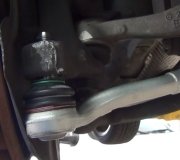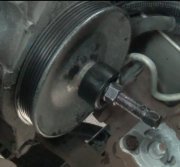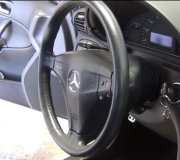Dandy. Are you referring to the inner tie rod end? If so, did the instructions mention using the fish scale? I'm suspicious that went away as far back as the early '90s, so yours would be a simple bolt-on part.
Regardless, the car will need to be aligned. The best you can hope for is if you started with a steering wheel that was centered when driving straight ahead, and you replace tie rod end(s) on only one side, you can readjust it until the steering wheel is straight again. If you have to replace tie rod ends on the other side, don't start that project until you have the first side done and a straight steering wheel. That way, when all parts are replaced and adjusted, total toe will be so close to specs that driving to the alignment shop will not be a frightful event. The car will handle reasonably well too.
Another point of common confusion refers to the tire wear you might be seeing. "Camber" is the inward or outward tilt of the wheel, as viewed from in front of the car looking back at the wheel. Positive camber means the wheel is tipped out on top. That's the most common as it places the vehicle's weight directly over the wheel bearing. When it's tipped out too far, that tire will run more on the outer edge of the tread and wear that area faster. The clue here is that wear will be excessive, but smooth, and it only affects that one tire.
Camber can be out of specs on both tires, and both can have wear on an edge of the tread, but each tire is only affected by its adjustment.
Toe is different. Individual toe can be off on one or both tires. If only on one, the steering wheel will be off-center. If it's off on both, such as when multiple parts have been replaced, it's anyone's guess where the steering wheel will be, but the important point is total toe is out of specs. Total toe always affects both tires on that axle equally. You have to turn the steering wheel to one side to make toe on each wheel equal so the car goes straight, and that can make the steering wheel off-center. If, for example, there's too much total toe-out, the wheels are both steering away from the center of the car. The tires will walk away until the sidewalls can't flex anymore, then they'll snap back and start all over. That scrubbing action is what sets up the feathered pattern we look for. Remember, that pattern will show up on both tires, but one can be worse than the other depending on whether camber is correct or not. You can usually see the featheredging, but if not, lightly run your fingertips over the tread. The block of rubber will have a raised side and a worn side. As you run your fingers, they'll run easily one way, but the other way they'll catch on the sharp edges. I used to be able to know if total toe was too much in or out based on the direction I ran my hand around the tire and across it, but it's been too long now to remember. The point of my sad story is if you feel that featheredge, or see accelerated wear on one edge, the car needs to be aligned.
If you're interested, here's a link to an article that does a better job of explaining tire wear patterns:
https://www.2carpros.com/articles/how-car-tires-work
Let me know if you have other concerns or when the alignment is finished.
Friday, December 8th, 2023 AT 5:19 PM



